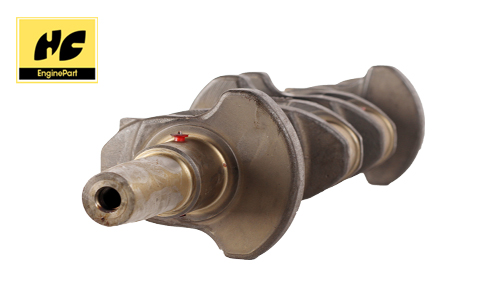Crankshaft wear reduction measures
2020-12-14

(1) When repairing, ensure the assembly quality
When assembling the crankshaft of a diesel engine, every step must be precise. Before installing the crankshaft, clean the crankshaft and clean the crankshaft oil passage with high-pressure air. Some crankshafts have side holes and they are blocked with screws. The impurities separated from the oil due to the centrifugal force will accumulate here. Remove the screws and clean them carefully.
When assembling the crankshaft, it is necessary to select high-quality bearings and be of the same level as the crankshaft to ensure that the contact area with the journal is more than 75%. The contact points must be scattered and consistent (by inspecting the bearing). The tightness must be appropriate. After tightening the bolts according to the specified torque, the bolts must rotate freely. Too tight will increase the wear of the crankshaft and the bearing, and too loose will cause the loss of oil and also increase the wear.
The axial clearance of the crankshaft is adjusted by the thrust pad. When repairing, if the axial gap is too large, the thrust pad should be replaced to ensure that the gap is within a certain range. Otherwise, the crankshaft will move back and forth when the vehicle goes up and down, causing abnormal wear of the connecting rod bearing and crankshaft.
(2) Ensure the quality and cleanliness of lubricating oil
Use lubricating oil of appropriate quality level. The appropriate diesel engine oil should be selected according to the load of the diesel engine. Lubricants of any quality grade will change during use. After a certain mileage, the performance will deteriorate, causing various problems to the diesel engine. During the operation of the diesel engine, the high-pressure unburned gas, moisture, acid, sulfur and nitrogen oxides in the combustion chamber will enter the crankcase through the gap between the piston ring and the cylinder wall, and mix with the metal powder worn out by the parts to form sludge. When the amount is small, it will be suspended in the oil, and when the amount is large, it will precipitate out of the oil, which will block the filter and oil holes. If the filter is blocked and the oil cannot pass through the filter element, it will rupture the filter element or open the safety valve, and pass through the bypass valve, bringing dirt back to the lubrication part, increasing oil pollution and aggravating crankshaft wear. Therefore, the oil should be changed regularly and the crankcase should be cleaned to keep the interior of the diesel engine clean so that the crankshaft can work better.
(3) Strictly control the working temperature of diesel engine
Temperature is closely related to lubrication. As the temperature increases, the oil viscosity becomes lower, and the oil film is not easy to form. The reason for the high temperature is poor heat dissipation of the cooling system, rust and scaling of the water radiator are common problems. Rust and scale will restrict the flow of coolant in the cooling system. Excessive scale will reduce the circulating flow of water, reduce the heat dissipation effect, and cause the diesel engine to overheat; at the same time, the reduction of the water channel section will increase the water pressure, causing water leakage or water filling Overflowing, insufficient cooling water, easy to open the pot; and the oxidation of the cooling liquid will also form acidic substances, which will corrode the metal parts of the water radiator and cause damage. Therefore, the water radiator should be cleaned regularly to remove the rust and scale in it to ensure the normal operation of the crankshaft. The excessive temperature of the diesel engine crankshaft is also related to the fuel injection time, so the fuel injection time must be adjusted correctly.